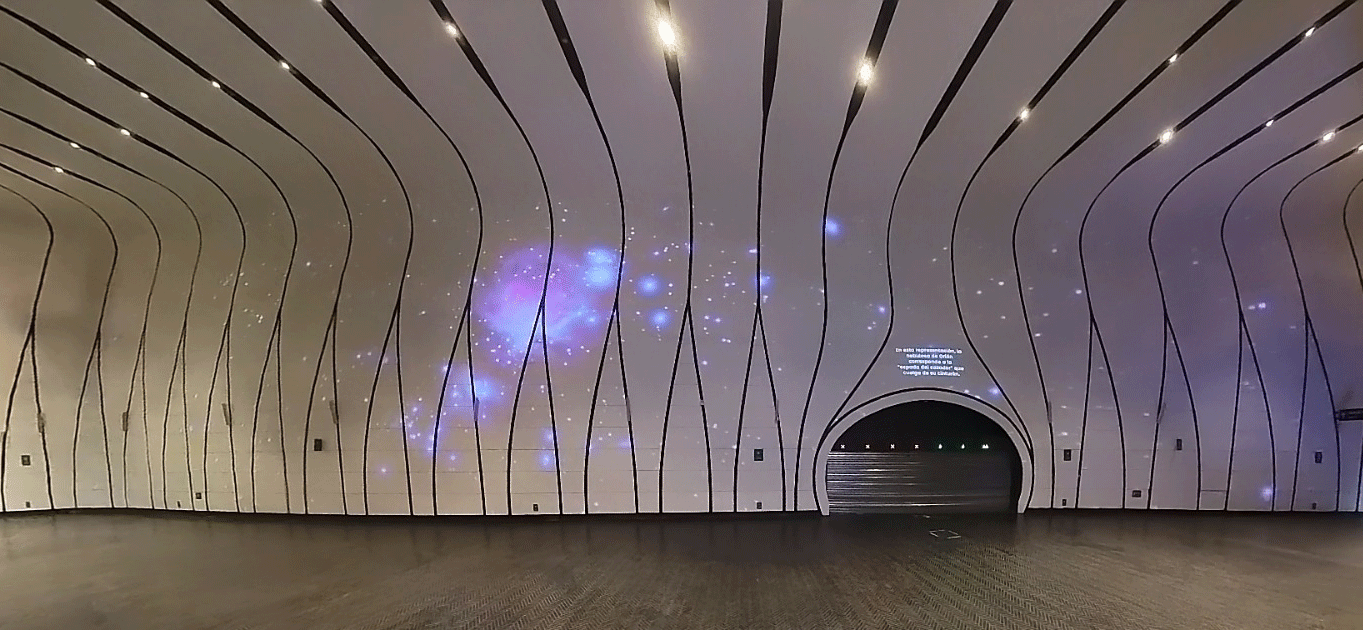[:en]
Ancient stars, of a type known as RR Lyrae, have been discovered in the center of the Milky Way for the first time, using ESO’s infrared VISTA telescope. RR Lyrae stars typically reside in ancient stellar populations over 10 billion years old. Their discovery suggests that the bulging center of the Milky Way likely grew through the merging of primordial star clusters. These stars may even be the remains of the most massive and oldest star cluster of the entire Milky Way, a genuine survivor.
A team led by Dante Minniti (Universidad Andrés Bello, Millennium Institute of astrophysics MAS and Center for Excellence in Astrophysics and Associated Technologies CATA) and Rodrigo Contreras Ramos (Millennium Institute of astrophysics MAS) used observations from the VISTA infrared survey telescope, as part of the Variables in the Via Lactea (VVV) ESO public survey, which carefully search the central part of the Milky Way. By observing infrared light, which is less affected by cosmic dust than visible light, and exploiting the excellent conditions at ESO’s Paranal Observatory, the team was able to get a clearer view of this region than ever before. They found a dozen ancient RR Lyrae stars at the heart of the Milky Way that were previously unknown.
Our Milky Way has a densely populated center — a feature common to many galaxies, but unique in that it is close enough to study in depth. This discovery of RR Lyrae stars provides compelling evidence that helps astronomers decide between two main theories on how nuclear bulges form.
RR Lyrae stars are typically found in dense globular clusters. They are variable stars, and the brightness of each RR Lyrae star fluctuates regularly. By observing the length of each cycle of brightening and dimming in an RR Lyrae, and also measuring the star’s brightness, astronomers can calculate its distance.
Unfortunately, these excellent distance-indicator stars are frequently outshone by younger, brighter stars and in some regions they are hidden by dust. Therefore, locating RR Lyrae stars right in the extremely crowded heart of the Milky Way was not possible until the public VVV survey was carried out using infrared light. Even so, the team described the task of locating the RR Lyrae stars amongst the crowded throng of brighter stars as “daunting”.
“Using data collected by the VVV, which surveyed the center of our galaxy for 6 years, we were the first ones to emphasize the fact that finding very faint variable stars in the entire central area was a possibility, which other studies failed to achieve,” MAS Researcher, Rodrigo Contreras Ramos, states.
Their hard work was rewarded with the identification of a dozen of RR Lyrae stars. Their discovery indicates that remnants of ancient globular clusters are scattered within the center of the Milky Way’s bulge.
Rodrigo Contreras Ramos elaborates: “For the first time we can confirm without a doubt our hypothesis, that is, the presence of old stars in the center of the Milky Way. This discovery of RR Lyrae Stars has important implications for the formation of galactic nuclei. The evidence supports the scenario in which the nuclear bulge was originally made out of a few globular clusters that merged.”
The theory that galactic nuclear bulges form through the merging of globular clusters is contested by the competing hypothesis that these bulges are actually due to the rapid accretion of gas. The unearthing of these RR Lyrae stars — almost always found in globular clusters — is very strong evidence that part of the Milky Way’s nuclear bulge did in fact form through merging. By extension, all other similar galactic bulges may have formed the same way.
These stars are not only powerful evidence for an important model of galactic evolution, but they are also clear evidence of the presence of 10 billion year-old stars in the center of our galaxy, which means that in spite of being dim, they are dogged survivors of perhaps the oldest and most massive star cluster within the Milky Way.
This recent discovery was published in the prestigious journal: The Astrophysical Journal Letters. According to the principal investigators, the following steps are to confirm new RR Lyrae candidates in this area, in order to add this information to the dozen already confirmed and to be able to study the chemistry of these real fossils of our galaxy.
“We are really excited because this discovery of the first RR Lyrae variables in this area of galactic nuclei opens many interesting possibilities. For instance, we are planning to measure the stars’ movements in order to see its orbits around the center of the galaxy where there’s a supermassive black hole, 4-million times heavier than our Sun. Plus, we have observation time at the VLT telescope, which will allow us to measure these stars’ chemical composition. Also, we plan to complete these RR Lyrae variables’ census in the galactic center to compare them with other stellar population,” Dante Minniti, MAS Deputy Director, ends.
Other researchers involved in this research are Manuela Zoccali (MAS Director and IA UC Researcher,) Óscar González (Astronomy Technology Centre in the UK, Royal Observatory, Edinburgh,) Marina Rejkuba and Elena Valenti (European Southern Observatory, Garching, Germany) and Felipe Gran (IA UC.)
Source: ESO
Image Credit: Variable stars close to the galactic centre. ESO/VVV Survey/D. Minniti
[:es]
Por primera vez, utilizando el telescopio infrarrojo VISTA de ESO, se ha descubierto, en el centro de la Vía Láctea, la presencia de estrellas antiguas de un tipo conocido como RR Lyrae. Las estrellas RR Lyrae normalmente se encuentran en poblaciones estelares antiguas de más de 10.000 millones de años de edad. Su descubrimiento sugiere que la parte más interna del bulbo Galáctico probablemente creció a través de la fusión de cúmulos de estrellas primordiales. Estas estrellas pueden ser incluso los restos del cúmulo estelar más viejo y masivo de toda la Vía Láctea, un auténtico superviviente.
Un equipo dirigido por Dante Minniti (Universidad Andrés Bello, Instituto Milenio de Astrofísica MAS, Centro de Astrofísica y Tecnologías Afines CATA) y Rodrigo Contreras Ramos (Pontificia Universidad Católica de Chile, Instituto Milenio de Astrofísica MAS) ha utilizado observaciones realizadas con el telescopio de rastreo infrarrojo VISTA que forman parte del sondeo público de ESO Variables en la Vía Láctea (VVV), el cual estudia minuciosamente la parte central de la Vía Láctea. Observando la luz infrarroja (que nos permite ver a través del polvo cósmico, cosa que no ocurre en el rango de la luz visible), y aprovechando las excelentes condiciones del Observatorio Paranal de ESO, el equipo pudo obtener la visión más clara obtenida hasta el momento de esta región. Encontraron una docena de viejas estrellas RR Lyrae en el corazón de la Vía Láctea que no se conocían previamente.
Nuestra Vía Láctea tiene un centro densamente poblado — una característica común en muchas galaxias, pero única en tanto en cuanto está lo suficientemente cerca como para poder estudiarlo en profundidad. Este descubrimiento de estrellas RR Lyrae proporciona una evidencia consistente que ayuda a los astrónomos a decidir entre dos teorías principales sobre cómo se forman los núcleos de los bulbos galácticos.
Las estrellas RR Lyrae suelen encontrarse en densos cúmulos globulares. Son estrellas variables, y el brillo de cada estrella RR Lyrae fluctúa regularmente. Observando la longitud de cada ciclo de aumento y disminución de brillo en una RR Lyrae, y midiendo el brillo de la estrella, los astrónomos pueden calcular su distancia.
Desafortunadamente, estas excelentes indicadoras de distancia suelen permanecer ocultas por el polvo o pierden su protagonismo porque hay estrellas jóvenes cercanas que brillan mucho más. Por lo tanto, localizar estrellas RR Lyrae justo en el superpoblado corazón de la Vía Láctea no fue posible hasta que se llevó a cabo el sondeo público VVV en luz infrarroja. Aun así, el equipo afirmó que la tarea de localizar estrellas RR Lyrae entre una multitud de las estrellas más brillantes fue “abrumadora”.
“Con los datos del VVV, que mapeó por seis años la zona central de nuestra galaxia, fuimos los primeros en poner énfasis en la potencialidad de encontrar estrellas variables muy débiles en toda el área central, lo que otros estudios no fueron capaces”, señala el investigador del MAS Rodrigo Contreras Ramos.
Un esfuerzo que fue recompensado con la identificación de una docena de estrellas RR Lyrae. Su descubrimiento indica que los vestigios de antiguos cúmulos globulares se encuentran dispersos en el centro del bulbo de la Vía Láctea.
Rodrigo Contreras Ramos, agrega: “Por primera vez podemos afirmar sin duda, algo que veníamos hipotizando, es decir, la existencia de viejas estrellas en el centro de la Vía Láctea. Este descubrimiento de estrellas RR Lyrae tiene importantes implicaciones en la formación de núcleos galácticos. La evidencia apoya el escenario en el que el núcleo del bulbo se creó a partir de la fusión de unos pocos cúmulos globulares”.
La teoría de que los centros de los bulbos galácticos se forman a partir de la fusión de cúmulos globulares es refutada por la hipótesis competidora, que plantea que estas regiones internas de las galaxias son el fruto de una rápida acumulación de gas. El descubrimiento de estas estrellas RR Lyrae, que casi siempre se encuentran en cúmulos globulares, es una evidencia importante de que la zona más interna del bulbo de la Vía Láctea se formó a través de la fusión. Por extensión, todos los núcleos galácticos similares podrían haberse formado del mismo modo.
Estas estrellas no son sólo una prueba para apoyar un importante modelo de la evolución galáctica, sino que además son una evidencia clara de la existencia de estrellas con edades de al menos 10.000 millones de años en el centro de nuestra galaxia, lo que significa que, pese a ser tenues, son las tenaces supervivientes del que podría ser el cúmulo de estrellas más antiguo y masivo dentro de la Vía Láctea.
Este reciente descubrimiento fue publicado en la prestigiosa revista The Astrophysical Journal Letters. Según los investigadores principales, los pasos a seguir en esta investigación es confirmar nuevos candidatos a RR Lyrae en esta zona, para sumarse a la docena ya corroborada y estudiar la química de estos verdaderos fósiles de nuestra Galaxia.
“Estamos muy entusiasmados porque este descubrimiento de las primeras variables RR Lyrae en la zona del núcleo galáctico abre varias posibilidades interesantes. Por ejemplo, planeamos medir los movimientos propios de las estrellas para ver sus órbitas alrededor del centro de la galaxia donde reside un agujero negro supermasivo, 4 millones de veces más pesado que nuestro Sol. Además, tenemos tiempo de observación en el telescopio VLT para medir las composiciones químicas de estas estrellas. También planeamos completar el censo de estas estrellas variables RR Lyrae en la región del centro galáctico para compararlas con otras poblaciones estelares”, concluye el subdirector del MAS, Dante Minniti.
Otros investigadores de esta investigación son Manuela Zoccali (directora del MAS e investigadora del IA UC), Óscar González (Centro de Tecnología Astronómica del Reino Unido, Real Observatorio, Edimburgo), Marina Rejkuba y Elena Valenti (Observatorio Europeo Austral, Garching, Alemania) y Felipe Gran (IA UC)
Fuente: ESO
Crédito imagen: Estrellas variables cerca del centro galáctico ESO/VVV Survey/D. Minniti[:]












